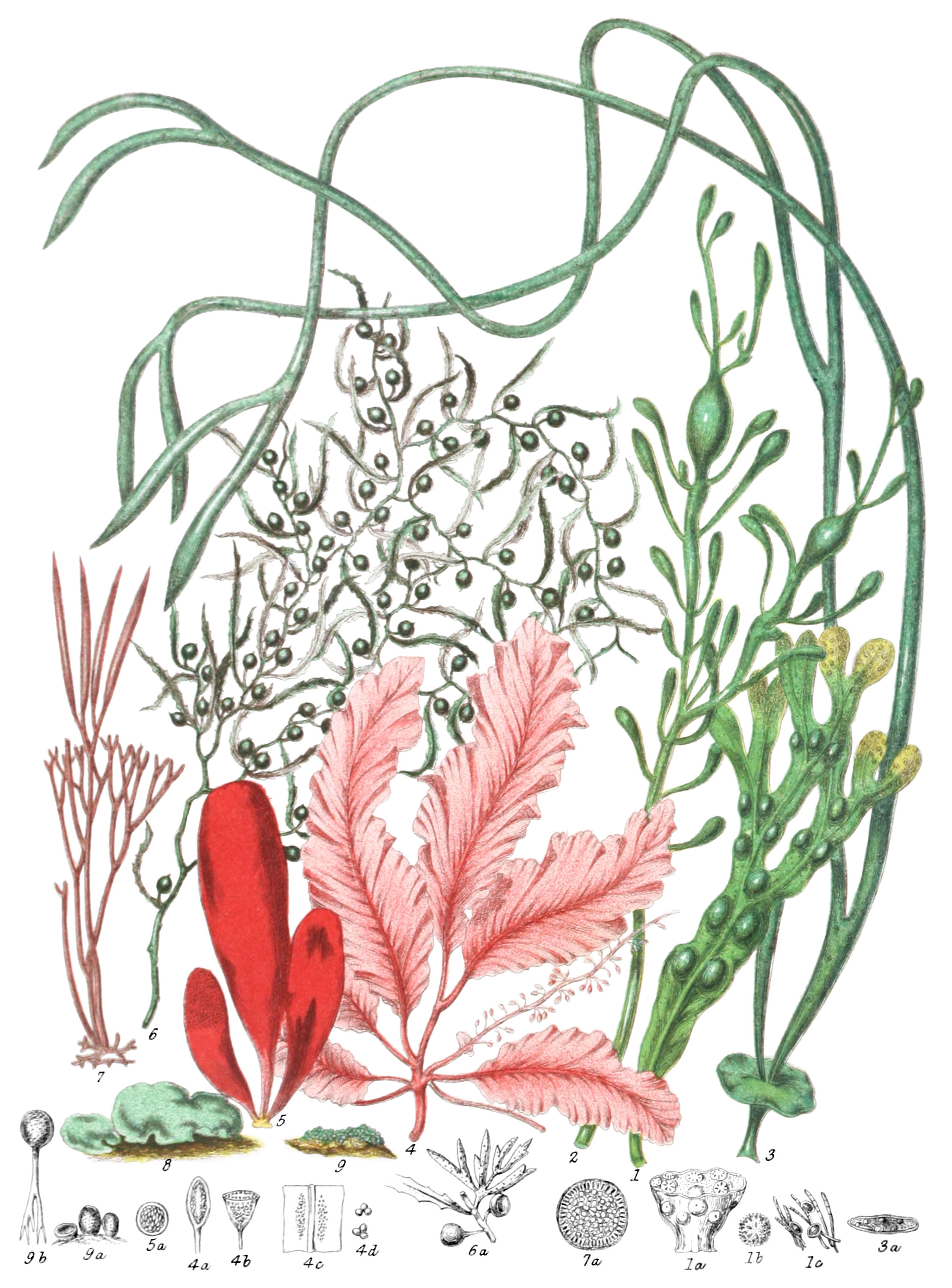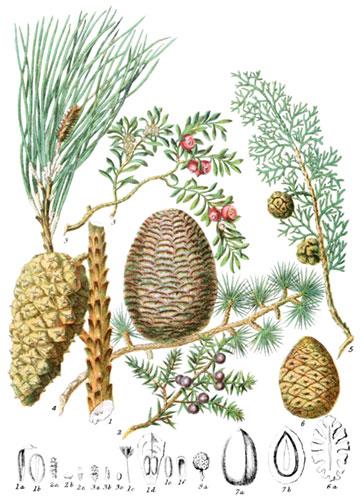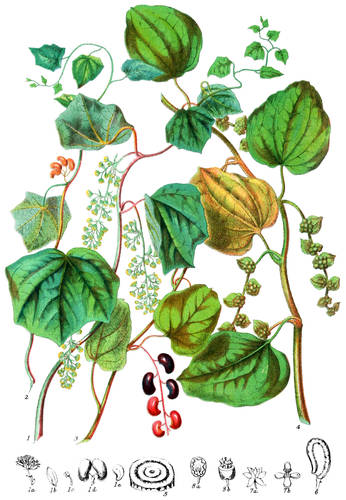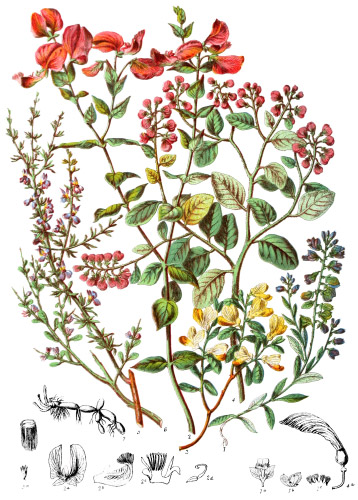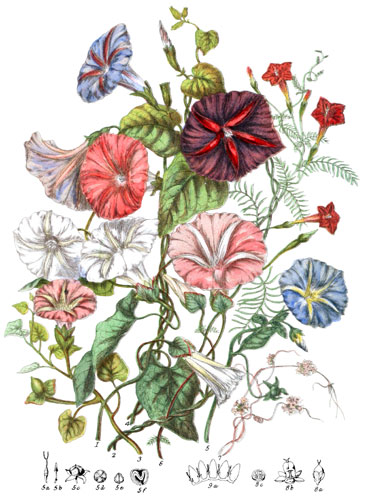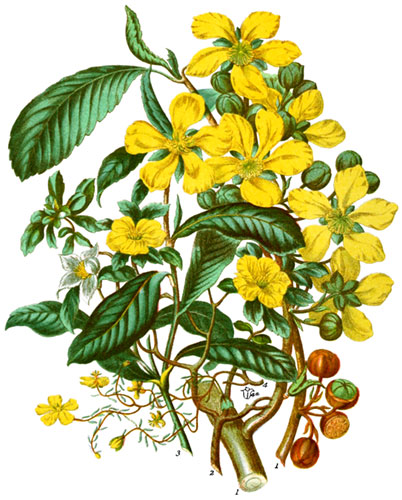Key characteristics
Plants composed of cellular tissue, inhabiting chiefly salt water, sometimes in fresh water, or hot springs; some grow in mud, others are attached to rocks. The frond is either composed of a single cell uninterruptedly branched, or of several cells of various forms, placed one above the other or interwoven, jointed or continuous, thread-shaped or of various figures, not uncommonly divided into a sort of stem and leaf. The fronds grow by division of the cells, and become branched by increasing at the sides. The plants are propagated by spores contained in bladdery vesicles scattered throughout the whole frond, or placed at the ends of the branches. Some are reproduced in two separate forms, rounded capsules, and minute ternate granules. The spores of some are furnished with fine hairs, which have the power of motion for a few hours before the spore begins to vegetate.
This Tribe has affinity with Characeæ.
These plants absorb carbonic acid and respire oxygen by day, and absorb oxygen and exhale carbonic acid by night. Some contain Iodine.
In each class of creation the lowest tribes are developed in water. Sea-weeds on the verge of vegetable life can only exist in water, or moisture. To the greater portion water is essential during the whole period of their existence. They have no vascular tissue, therefore no circulation of fluids; they absorb water only by the parts in immediate contact with it; the most expanded fronds have no power of conveying moisture to the rest of the plant, neither can the roots obtain nourishment by their points as those of higher tribes. They serve merely to attach the plant to the rock, and prevent it from being floated away by waves; it matters not whether it be granite or marble, if it be only solid and favourably placed.
Select plants in this order
Not all plants listed are illustrated and not all plants illustrated are listed.
- Fucus, which has given its name to the whole Tribe, is a very extensive genus, abounding on the coasts of the British Isles.
- F. vesiculosus (1) is of considerable value in making kelp. The receptacles lined with spores are at the ends of the branches; the air-vessels are in pairs throughout the frond. The Western Isles of Scotland derive much benefit from this species; not only is it used for kelp, but it serves also as winter food for cattle; when dried it is used as fuel, and the ashes are laid over cheeses to dry them.
- F. nodosus (2) is like other species, very tough and leathery, growing to a large size in deep water. Some have receptacles of great length, forming nearly the whole plant, the spores immersed in them irregularly, as Himanthalia lorea (3).
- In the same section of this tribe is one of the most remarkable examples of extended growth, the genus Sargassum.
- S. bacciferum (6) does not grow on the British coast, but is often washed ashore on the Orkney Isles from the Atlantic. In S. America it is thought a remedy for goitre.
- A large mass of this species, as well as of S. vulgare, exists in the Atlantic between 19° and 34° of N. lat. west of the Azores, the same floating meadow which impeded the ships of Columbus on his voyage of discovery. Another lesser mass is observed between Bermuda and the Bahamas.
- The largest British sea-weeds belong to the genus Laminaria; the frond is flat and extremely tough, has no mid-rib; the fructification forming dense spots embedded in the thickened surface of the frond.
- The stem of L. digitata has a stem of 6 feet, with a frond often more than 15 feet in length, divided into numerous segments. When dry it is covered with salt, which has a sweetish taste and has given the specific name.
- The stem of L. potatorum of New Holland is of a size to serve as water-vessels.
- L. buccinalis is the great Trumpet-weed of the Cape.
- Scytosiphon filum† grows to 40 feet in the bays of the Orkney Isles.
- Alaria esculenta has a frond of upwards of 20 feet, the surface covered with pores, from whence issue tufts and filaments.
- But the giant of the tribe and of all vegetation is Macrocystis pyrifera, 1500 feet long, floating in southern latitudes.
- Delesseria is the most beautiful of British sea-weeds; D. sanguinea (4) retains its brilliant hue when dried, adhering to paper. The fructification is of two kinds, round capsules containing a globular mass of seeds, or ternate granules, scattered in the frond or in small leaf-like processes on a mid-rib from which the rest of the leaf has fallen away.
- Amongst the eatable kinds known as Dulse in Scotland is Iridæa edulis (5) of a very succulent nature, yielding a fine red dye if prepared with alum.
- Rhodomenia palmata is mucilaginous, and affords wholesome food to sheep in Norway; it is eaten in Edinburgh by the poor. The Icelanders also make it part of their humble fare, either raw or boiled in milk.
- Furcellaria (7) is a genus of dark coloured species abundant on all European coasts; the cylindrical receptacles fall off when ripe, leaving the branches to grow again.
- A terrestrial example of this Tribe is Ulva crispa (8), to be found in winter on damp ground in shaded places. The granules are arranged in regular lines forming squares, for even in this lowly plant beauty and order are perceptible.
- Still lower in the rank of plants is Botrydium (9),‡ composed of minute vesicles filled with a fluid which escapes at the top, and the plant becomes cup-shaped.
- Yet more simple and lowly is the Protococcus nivalis, the red snow of the Polar regions and of the Alps; consisting of minute globules of red fluid, bursting when ripe.
- The gelatinous nature of many sea-weeds renders them useful to the Chinese and other Eastern nations, as food, glue, or varnish. Some are employed as dyes.
Locations
This Tribe exists in salt or fresh water all over the globe, forming extensive forests in the depths of the ocean, and floating on its surface in prodigious masses, comprising the largest examples of vegetation, and the most minute. Some species are found in boiling springs, others on perpetual snow. Durvillæa extends to 61° S. lat.; Scyothalia as far as 63°.
Legend
- Fucus vesiculosus. Coast, Britain.
- Section of Receptacle.
- Spores.
- Spores and Filaments.
- Fucus nodosus. Coasts, Britain.
- Himanthalia lorea. South coast, England.
- Section of Receptacle.
- Delesseria sanguinea. South coast, England.
- Receptacle.
- Section.
- Spores on Frond.
- Spores.
- Iridæa edulis. Shores, Scotland.
- Spores.
- Sargassum bacciferum. Atlantic Ocean.
- Receptacles and air-vessels.
- Furcellaria fastigiata. Shores, Britain.
- Section of Receptacle.
- Ulva crispa. Damp gravel, England.
- Botrydium granulatum.‡ Gravel, England.
- *9a and 9b were not named in the original description.
- †Scytosiphon was spelled “Seytosiphon” in the original description.
- ‡Botrydium was spelled “Batrydium” and “Botnydium” in the original description.
Explore more
Posters
Decorate your walls with colorful detailed posters based on Elizabeth Twining’s beautiful two-volume set from 1868.
Puzzles
Challenge yourself or someone else to assemble a puzzle of all 160 botanical illustrations.
